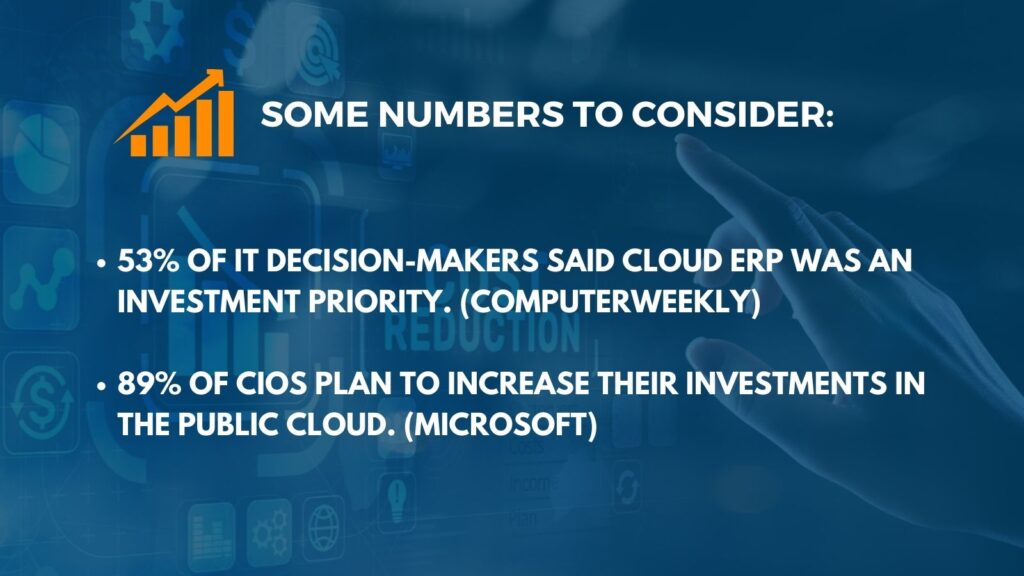Free Up IT Resources by Moving Your ERP to the Cloud
In today's business environment, IT staff are highly skilled workers who can demand a significant salary. Do you ever wonder how you can justify the expense of your IT team to the CFO? If IT cost reduction is on your mind, perhaps you look for ways to increase productivity to show a higher ROI on salary expenses.
What if there was a way to reduce IT costs without eliminating staff?

Good news: there is. Move your ERP to the Cloud. Not only will you reduce your IT expenditure, but your organization will also realize a host of benefits ranging from staff efficiency across the board to greater data security – and an increased competitive edge.
Why Cloud ERP?
Cloud ERP checks many boxes as a comprehensive solution, not the least of which is its role as a financial management tool. While Cloud ERP appeals to many because of its back-office capabilities, for some businesses, the most significant benefit of ERP is the transformation it brings to IT.

IT department staffing and costs have skyrocketed in recent decades. Cloud ERP
can free your skilled workers from time-consuming tasks, allowing them to focus on more profitable work. Let's start with some numbers that show the relationship between cloud ERP and IT.
IT Costs and Cloud ERP
Surprisingly, smaller businesses spend a higher percentage of their revenue on information technology than larger ones.
Small businesses with less than $50 million in revenue spend 6.9% on IT. IT spending accounts for 4.1% of revenue for mid-sized companies, with revenues ranging from $50 million to $2 billion. Finally, enterprise-scale businesses only spend 3.2% of their revenue on IT.
IT has historically been burdened by extensive maintenance work. Historically, this was due to the significant upfront capital expenditure inherent in many IT solutions. Modern solutions, such as cloud ERP, have alleviated these problems. Is there still room for cost-cutting in terms of staffing?
ERP as a tool for IT transformation
Consider the impact of cloud ERP on the quality of work done in IT. Many companies embrace the opportunity to reallocate resources. That may be a more valuable way to consider the impact of cloud ERP on IT staff.
Cloud ERP as an IT solution can save your IT staff a lot of time by offloading infrastructure and reducing work hours dedicated to infrastructure maintenance. Your IT team can then concentrate on what they do best: innovate.
Introducing cloud ERP into your organization allows IT to pivot, focusing on the technologies and innovations your company requires to stay competitive.
Greater staff efficiency throughout the organization
Cloud ERP can transform how everyone in your company works. ERP exists to transform the "how" of work, not the "what." Rather than cutting staff in any department, you can use IT to reposition employees, streamline workflows, and create a new environment where each task yields significant ROI.
Cloud ERP systems use a combination of technologies linked by high-speed internet networks. The Cloud ERP is always online, and the ERP provider handles security updates. All your team needs to do is log in and use the ERP and its underlying data. That results in a lower total ownership cost than previous-generation ERP systems hosted on company-owned servers.
Cloud ERPs are accessible via mobile devices or desktop computers. They include diverse business applications designed to keep your company running smoothly, providing a positive customer experience and achieving profitable business outcomes.
Cloud-based ERPs enable your team to access any information they require wherever their work takes them, from customer sales meetings to remote work sites to your home office. With more workers than ever working from home or other locations since the pandemic, the ability to securely log in from anywhere cannot be overstated.
Among the highlights are easy access to customer information, sales histories, financial data, human resource management tools, live operating metrics, supply chain status, and other features. A cloud ERP can connect virtually any computer system your business requires.
Unlike on-premise ERP systems, cloud-based ERP is hosted and managed by the vendor, who offers the software "as a service" via the Cloud. The vendor is in charge of the application, data storage, underlying operating system, servers, physical data center infrastructure, and the installation of security updates and feature upgrades.
8 Advantages of Cloud ERP Software
In addition to the staffing cost efficiencies that can be realized, cloud ERP offers many other benefits that can lead to greater productivity and profitability in every aspect of the business.
Here are some of the features and benefits that our customers find most valuable:
- Infrastructure and operational costs. One of the most significant advantages of a cloud-based ERP solution is lower overall costs, which begin with implementation. With on-premise ERP, a company incurs many expenses, including servers, database creation, initial implementation, consultants, IT staffing, security, and backup.
Cloud ERP is typically 30% less expensive than on-premise ERP. Companies that use an on-premise ERP system will incur additional costs for maintenance, specialized in-house or on-call resources, upgrades and updates, and additional servers as their business grows. Companies avoid upfront infrastructure and other expenses for IT staff, maintenance, security, and updates because your cloud ERP partner hosts and manages the software on its servers. The vendor offers ongoing IT assistance.
- Rapid implementation. A cloud-based ERP system can typically get a business up and running faster than an on-premise ERP system because it does not require selecting and configuring hardware or hiring and training IT staff. One of the most significant challenges of any new ERP solution is implementation time, which can directly affect business downtime and time to value.
- Accessibility. Users of cloud-based ERP can access business information in real-time from any location and on any device. Regardless of the business unit or location, employees work with the same data and can make decisions more quickly and confidently.
- Scalability. Cloud-based ERP solutions simplify scaling a business by eliminating the challenges of adding more servers for more users, locations, or subsidiaries. As a company grows, so does its use of cloud ERP.
An organization can begin with the fundamental core functionality and expand as needed—all without additional hardware. A cloud ERP solution enables users worldwide to access business information by connecting to the internet. Because no local servers are required, new units can come online quickly as a company grows through mergers or acquisitions. Cloud vendors typically own data centers worldwide and store each customer's data in multiple locations, providing a better and more reliable service than most businesses can manage. Cloud software vendors typically strive for 99.999% availability, which translates to less than eight minutes of unplanned downtime per year for customers.
- Customization and adaptability. Cloud-based ERP can scale with an organization and be more easily customized to meet the needs of the business, either from the start or over time, as the business grows and evolves. You can customize your on-premise ERP software, but those customizations anchor you to the current software. They may be challenging to reimplement with future versions, especially with in-house developed integrations. It's one of the primary reasons some companies delay upgrading their on-premise ERP systems and continue using outdated technology.
Furthermore, cloud ERP systems integrate well with other cloud-based products, and you can add new modules to a cloud ERP system without downtime or additional hardware. This type of agility allows a company to be proactive rather than reactive, adapting more quickly to industry changes, consumer trends, unforeseen circumstances, and other factors.
- Upgrades. Cloud ERP partners manage all system upgrades and updates continuously, keeping up with changing business needs and ensuring customers can access the most recent technology. Cloud ERP updates are quick to execute and are typically performed during off hours to avoid business disruptions. Updating or upgrading on-premise ERP software takes more time and may even necessitate hiring contractors to oversee the process.
- Security, compliance, and disaster recovery. They are all priorities. Many businesses are understandably concerned about entrusting their data to an external vendor. Cloud-based ERP providers, on the other hand, can provide better security and compliance than companies could otherwise afford. Furthermore, a company can be confident about its data backups and that the vendor has disaster recovery procedures that have been planned and practiced.
On-premise ERP solutions risk catastrophic data loss in the event of hardware or software failure, natural disaster, fire, or break-in unless organizations have a disaster recovery and business continuity plan.
Cloud providers typically provide enterprise-grade security and end-to-end data encryption between the vendor and the organization. Companies are responsible for cloud ERP users' identity and access management and the security of devices such as PCs or smartphones.
- Storage availability and resilience. If on-premise hardware fails, a company may have to spend significant time and money transferring data to a new storage system. The ERP partner stores the data in its data centers, which are usually geographically distributed. It's also advantageous in providing internet access to business information and data. It is becoming increasingly important as more jobs and operations move online, and businesses seek to automate and streamline business processes.
Ready to implement cloud ERP?
Whether considering upgrading your ERP or implementing a system for the first time, the Liberty Grove team of ERP consultants can guide you through each step for a smooth ERP solution.
We ensure that your new system receives the attention required to be ready to go in your business environment from the moment you engage with Liberty Grove Software. We'll provide the services you need to guide you through project planning, implementation, testing, training, and ongoing support.
Contact Liberty Grove for a complimentary consultation on how Cloud ERP can reduce costs and elevate your business to the next level.
About the author
Liberty Grove Software is an established Microsoft Partner that focuses on providing customers with sales, service, and support for Microsoft Dynamics 365 Business Central/NAV solutions and training and upgrades.
Over more than 25 years, Liberty Grove has assisted hundreds of customers with businesses ranging from small to mid-sized to Microsoft Partners in implementing, training, customization, and upgrading Microsoft Dynamics ERP solutions.
The organization is one of only a few companies worldwide that Microsoft recognizes as qualified to provide Business Central/NAV Upgrade Service Centers.

